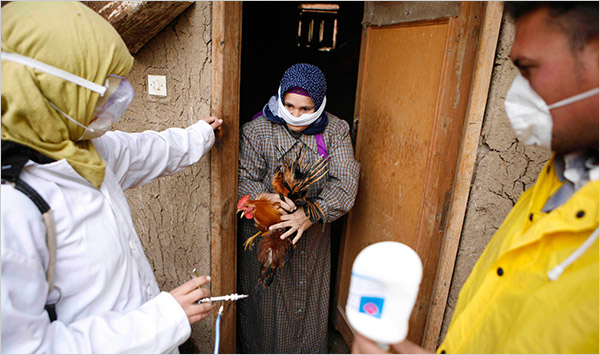Bird flu in Egyptian children -- it may or may not be "hot air," but it's also something different.
 As we all know, and as the New York Times has dutifully picked up on in today's editions: There is something decidedly different going on in Egypt right now. The number of human cases seems to be accelerating, with almost a case a day on average in the past week alone.
As we all know, and as the New York Times has dutifully picked up on in today's editions: There is something decidedly different going on in Egypt right now. The number of human cases seems to be accelerating, with almost a case a day on average in the past week alone.
Not just that: The news reports of a dead 6-year old boy, first admitted to hospital on march 28th of this year, breaks a pattern of (generally) mild H5N1 symptoms in younger children and returns the virus to lethal status. The dead boy lived in what MSNBC calls a "gritty" suburb of Cairo.
I have not taken the time to map the locations of the numerous human cases, but Dr. Henry Niman has, and it can be seen here. The data are pretty amazing to see mapped out.
And if you look at the chatter on Egyptian Websites, especially news-gathering sites, the number of suspected cases continues to climb and will continue to climb.
In the past several weeks, the human cases seemed to be confirmed to younger children, and the virus itself seemed to be mild. In fact, the virus' effects seemed to be so mild that speculation began to infect even the highest scientific and medical circles that a mild form of human H5N1 might be circulating all along the Nile Delta. This speculation was added to be others who then began to openly speculate about the possible presence of asymptomatic human carriers of H5N1. Asymptomatic human carriers of a pandemic-ready virus, whether or not it was capable of sustained human-to-human transmission, would mark the official Tipping Point of H5N1's transition from killer of birds to mass murderer of humans.
But last week, the first two adult cases of H5N1 in several weeks surfaced. Curiously, the two adult cases were female -- a pattern we have seen before.
However, the cacophony regarding the possible presence of asymptomatic human carriers was not universal. Far from it: The Pope of Influenza himself, Dr. Robert G. Webster of St. Jude, proclaimed that all this worry was a lot of "hot air." From the New York Times:
“Right now, it’s all hot air,” said Dr. Robert G. Webster, a flu expert at St. Jude Children’s Research Hospital in Memphis. “I hope to hell it’s not happening, because it would mean the virus is adapting to humans. But there’s not a shred of data.”
I admire and respect Dr. Webster greatly, and I communicate with his protege on occasion. Another scientist who is in my personal Hall of Fame is the late Dr. J. Allen Hynek, founder of the Center for UFO Studies, and was a consultant to the USAF's Project Blue Book. But Hynek is probably and wincingly best known for his proclamation that certain Michigan 1960's UFO sightings were "swamp gas." Of course, he was taken out of context -- but the comment remained.
So, hopefully, Doctor Webster's "hot air" comment will be borne out; because if not, as he says, it would mean the H5N1 virus would have evolved toward H2H transmission. But his tone also suggests he has had the opportunity to personally view samples of the Egyptian virus, as a WHO world-class reference lab. The Egyptian government is refreshingly transparent when it comes to reporting and disclosing bird flu cases and samples.
One thing is absolutely certain: The number of human H5N1 cases in Egypt is double that of the entire year of 2008. It is on track to be the worst year for human H5N1 in Egypt since its introduction in 2006. More than 6,000 Egyptians have been suspected of having H5N1 and were given Tamiflu as a precaution. Egypt is averaging a confirmed human case of H5N1 every six days. At this rate, and even factoring in seasonal fluctuations in the virus' appearance, it will be a long 2009 for the Egyptian government and its people.
The concept of asymptomatic human carriers being the final prerequisite for pandemic is not new; as readers know, I frequently refer to the good works of the late Dr. R. Edgar Hope-Simpson, who felt that a pandemic would not start with any sort of localized outbreak; rather, it would start with simultaneous infections either across a continent or across many continents. These asymptomatic carriers of infections would explain the ability of previous flu pandemics to "jump" across entire oceans and mountain ranges within days of the diagnosis of preliminary cases. It would help explain the argument about whether the Spanish Flu first appeared in China or in Kansas; whether it first appeared in pigs or in people. The answer would be "yes."
The world needs to stay focused on Egypt. The news coming out of there is bad, bad, bad.

Reader Comments